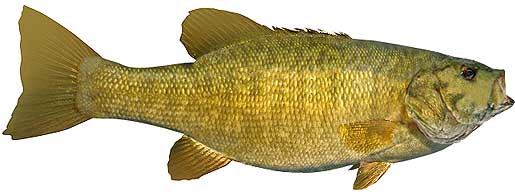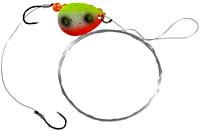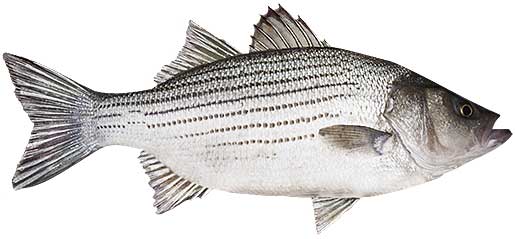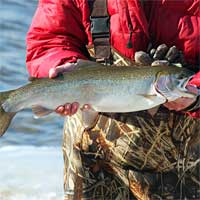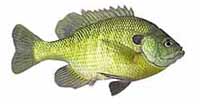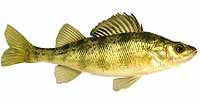Fishing Report For Lake Pueblo, CO
By Rick Seaman
Last updated on .

Fishing Reports
Popular Fish Species Lake Pueblo, CO
Smallmouth Bass
Current Report: Good
The quality of smallmouth bass in Pueblo makes it a favorite for bass tournaments. The lake is strewn with rock and boulders, which make ideal cover for a smallmouth bass fishery.
FALL. Fall is in full swing and smallmouth have followed schools of baitfish into coves and bays 6 to 18 feet deep. They thrive in the cold, clean water, which is an ideal environment for them. Rocky shorelines and points around the North Shore Marina, and the North Shore area, are good feeding grounds for smallies in Fall. Locals report that tube jigs are a great choice when the bass are around 15 feet deep. Drop shot rigs with small worms or shad shaped plastics are also popular in 10' water or deeper. Jerkbaits, deep-diving crankbaits, and slow-rolled spinnerbaits, are also successful, when bass are shallow to mid depth. Later in Fall, smallmouth move to slightly deeper water, around 10 to 25 feet deep. Fishing shallow for smallmouth is often good on cold, windy, cloudy and rainy days.
WINTER. Winter will isolate them around deeper structure, points, flats and creek channels, often suspending in open water above these features. They can generally be found from 10 to 30 feet deep. Jigging spoons, tube baits, drop-shot worms, jigs and Ned rigs tend to temp smallmouth in deep water. I like to work these deeper haunts very slowly, as the bass are somewhat sluggish. Here they hold, feeding less frequently, awaiting warmer water to return in Spring.
SPRING. After ice out, when water temperatures rise into the 50's, smallmouth move from deep wintering spots to shallower water, just outside spawning areas. They feed heavily in 2 to 12 feet of water at this time, and are typically caught on jerkbaits, crankbaits, tube baits, Ned rigs, and crayfish imitating plastics. Once water warms into the high 50's, they move into shallower water, and create nests in gravel or sand areas, then lay their eggs. Females then move to deeper water and males remain to guard the eggs, and then the fry. After a couple weeks, the males also move into 15 to 18 feet deep, and feed aggressively. Crankbaits, tube baits, Ned rigs, plastic worms, spoons and swimbaits are catching smallies during this period.
SUMMER. Smallmouth bass are currently feeding shallow early and late in the day in 3 to 8 feet of water. They are being caught on topwater, crankbaits, swimbaits, Ned rigs and tube baits. Smallmouth bass here feed on crawfish, gizzard shad, and small sunfish. They prefer rocky or gravel bottom areas, as this is where crayfish live. During the hotter parts of the day, they are being caught on points, humps, and ledges around 20 feet deep. Often these deeper fish tend to school, so finding them can deliver some fast action. Anglers fishing around the section of the lake nearby North Shore Marina, and the North Shore area, report good catches in Summer.
Walleye
Current Report: Good To Very Good
FALL. Fall brought cooler temperatures to shallow water, pushing walleye and baitfish back toward deeper haunts. Walleye continue to be a major draw for anglers. Locals report catching nice walleye on long points, flats along the river and creek channels, and structure off shore. Jigs, swimbaits, spoons, crankbaits, jerkbaits, and spinnerbaits are all historically good for catching walleye this time of year. Early and late in the day finds them in 8 to 12 feet of water, mid day they hold 15 to 25 feet deep. Later in Fall, they move out slightly deeper. Dragging jigs, bottom bouncers, or worm harnesses with nightcrawlers or leeches, around ledge drop-offs is catching walleye fairly consistently. Watch for the bigger walleye to be slightly deeper than the majority of the school.
WINTER. This Winter, fishing for walleye has been pretty good, as it has been for the last few years. Anglers report catching them in the main basin area, in 12 to 30 feet of water, along deep creek channel edges, rocky humps and ledges. Steep drops in the area toward the dam are also producing during these cold months. They primarily feed on small fish, staying close to the bottom. Blade baits, jigs, swimbaits, spoons, deep-diving crankbaits, and worm harness spinners, all work while deep trolling or drifting.
SPRING. Early Spring brings warming water in the shallows, and draws walleye here to feed, especially flats off the main channel, shallow points, creeks, and the mouths of inflowing water. In Spring work points, drop offs, submerged structure, rock ledges, flats and flats adjacent to deeper water. Here, in 4 to 12 feet deep, they will spawn once the water warms to the mid to high 40's. When they move shallow, bright colored jigs, tipped with minnows or nightcrawlers typically catch them. Spinnerbaits, jerkbaits and crankbaits are also working when walleye are up shallow. Afterwards, they move to 10 to 18 feet deep around points, flats, shoals and ledges, nearby shore, often staying in close proximity to their spawning locations. Main lake drop offs are producing nice fish.
SUMMER. Water temperatures rise in Summer, and walleye fishing is good if you can get your bait deep enough. Early in Summer, walleye tend to concentrate in 6 to 15 feet of water. Throughout Summer, early in the morning, and from dusk to long after dark are good times to catch walleye. At those times they move slightly shallower to feed in low-light conditions. Night fishing is often good in Summer, as well. The rest of the time they are cruising flats and creek channel edges, 15 to 22 feet deep , preferring the cooler temperatures. When the bite is slow, grubs and nightcrawlers, fished just off the bottom typically catch walleye.
Hybrid Striped Bass
Current Report: Good To Very Good
Also known as wipers, hybrid striped bass are abundant in Lake Pueblo. According to reports by locals, you can catch a bunch of them once you locate a school. Using electronics and fish finders to locate both bait and wipers, improves the odds of good fishing.
FALL. In Fall, hybrid stripers return to shallow water, the upper end of the lake, and into inflowing water if available. Early in the day wipers chase bait to the surface and feed aggressively, making this an excellent time for topwater action. Mid day they move into 8 to 20 feet of water, around ledges off the main channel, humps and points. Look for structure nearby deeper sections of the channel, and fish them thoroughly. Most any lure that resembles baitfish will catch wipers at this time of year.
WINTER. In Winter, hybrid stripers again hang out in deeper water and feed close to the bottom, often 30 feet deep or deeper. Warm afternoons occasionally draw stripers shallower, so look for them around the 14 to 22-foot range as they feed on roaming schools of gizzard shad. In Winter it is important to locate schools of bait, then look for wipers schooling below the bait. Fish finders, and forward facing sonar, are a big help in locating these roaming schools. Nice fish are being caught while trolling or drift fishing. Spoons, swimbaits, blade baits, crankbaits, live bait and cut bait are typically effective this time of year. Due to slower metabolism, anglers are triggering more strikes as deep as 30 feet, by making slower presentations.
SPRING. When water temperatures rise into the mid 60's now, it's the ideal time for hybrid stripers to spawn. There are plenty of hybrids averaging 2 to 3 pounds, with an occasional 4-pound plus fish being caught. In Spring, work wind-blown points, creeks, and the upper end of the lake if there is inflowing water. If they spawn, they will lay eggs in flowing water. Look for holes in the river channels, as they are a good holding place for hybrid stripers after the spawn. The remainder of the Spring is spent migrating back to the main basin, feeding in 6 to 18 feet of water.
SUMMER. In Summer, these wipers typically hang out in 15 to 25 feet of water, staying close to schools of bait. Sometimes during the heat of the day they move close to the bottom. Morning often draws hybrid stripers to much shallower water, so look for them around the 2 to 8-foot range as they feed on shallow on roaming schools of gizzard shad. Being successful at fishing for stripers in Summer is a matter of locating schools of bait, and the wolf packs of wipers are likely to be nearby. Fish finders, and sonar electronics, are a big help in locating these roaming schools. Nice wipers are being caught by casting, trolling or drift fishing. Spoons, blade baits, crankbaits, live bait and cut bait are all effective here.
Fishing Video
Fish species to fish for...
Guide to fishing for largemouth bass, smallmouth bass, channel catfish, blue catfish, flathead catfish, black crappie, walleye, rainbow trout, rainbow/cutthroat hybrid, bluegill, yellow perch, saugeye, and wiper at Lake Pueblo in Colorado.
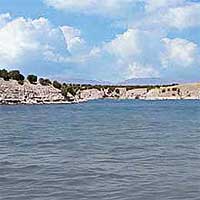 Pueblo Reservoir is a 4,000 surface acre lake with 60 miles of shoreline and a nice variety of fish. Bass, walleye, crappies, trout, catfish, perch, sunfish, saugeye and wipers all draw fishing enthusiasts for both warm-water and cold-water species. Boats are available for rent.
Pueblo Reservoir is a 4,000 surface acre lake with 60 miles of shoreline and a nice variety of fish. Bass, walleye, crappies, trout, catfish, perch, sunfish, saugeye and wipers all draw fishing enthusiasts for both warm-water and cold-water species. Boats are available for rent.
Primary fish species to catch
Click images for fishing tips and details about each species.
Today's Weather & Forecast
Fishing Boat Rentals
Click here for fishing boat rentals.
Marinas
Click here for marinas.
Public Boat Launch Ramps & Landings
Click here for boat ramps.
Fishing License
Click here for a Colorado fishing license.
Map - Fishing & Access
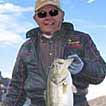 Rick Seaman is a fishing enthusiast with over five decades of fishing experience, a retired tournament fisherman, author of numerous published articles on fishing, and co-author of the book "Bass Fishing - It's not WHAT you throw, It's WHERE you throw it".
Rick Seaman is a fishing enthusiast with over five decades of fishing experience, a retired tournament fisherman, author of numerous published articles on fishing, and co-author of the book "Bass Fishing - It's not WHAT you throw, It's WHERE you throw it".
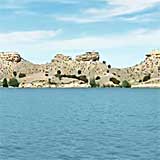 Contact Information
Contact Information
Lake Pueblo State Park
640 Pueblo Reservoir Rd
Pueblo, CO 81005
970 522-3657
Fishing lakes in each state
111225
Lake Pueblo, CO Report
COLORADO


Fishing for walleye, bass, wiper, catfish and crappie in central CO.


